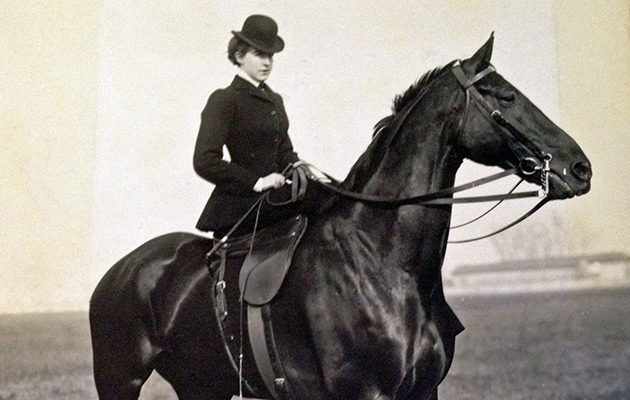Exiled from France, Princess Hélène of Orléans, an accomplished sportswoman, found herself at home in Africa, as Ettie Neil-Gallacher reports
A noted foxhunter and fine shot, Princess Hélène of Orléans was remarkable for her passionate devotion to Africa – travelling there throughout her life, even when ill health did not recommend it. Ettie Neil-Gallacher shares the sporting story of a Victorian Diana.
For more sporting Dianas, seriously sporting ladies offering advice and encouragement, Yvonne Goss has won eight National Championships titles and the Golden Button Challenge three times. And Anastasia Sparrow is shooting alongside Team GB as she trains for Olympic Trap.
PRINCESS HELENE OF ORLEANS
Princess Hélène of Orléans (1871-1951) was one of a coterie of Victorian Sporting Dianas who embraced the fieldsports world with vigorous enthusiasm.
An imposing figure, standing at more than 6ft tall, she was born in exile in Twickenham in 1871. Apart from brief spells back in France she spent most of her formative years in Britain, where her mother, the Infanta Maria Isabel of Spain, was renowned for being the finest shot and rider of her day. She ensured that all her children became, “fearless riders, indefatigable walkers and good shots”, The Field noted. Hélène was regularly cited as being a fine shot, although her older sister was a crack one. Hélène was, “able to handle a gun with little less dexterity than her sister, Queen Amélie of Portugal, that acknowledged expert,” cooed Tatler. She was, however, a far bolder rider than her older sister, and became a noted, and devoted, foxhunter, as well as an adept angler and stalker.
John Busvine, tailor and riding habit maker to preeminent Victorian Dianas, advertised her name, alongside The Princess of Wales and The Empress of Austria, as one of the hard-riding models showcasing his tailoring skills. She was one of the first to adopt Busvine’s Convertible Apron Skirt, starting to wear one as soon as Busvine invented them in 1894 (their purpose to prevent the risk of being dragged after a fall).

Princess Hélène of Orléans with a water buffalo, shot near Neumann Camp, northeast of Mount Kenya, 1910.
In the 1900s, when she lived in Italy, Hélène was one of the hardest riders to hounds with the Rome Hunt, the oldest hunt on the Contintent. “Meets take place twice weekly,” noted The Bystander in 1907, “and the foxes, at any rate, find the ancient aquaducts and temples very good cover.” The going on the Campagna proved excellent, more than a match to hunting in Pau or Gibraltar.
What makes Hélène’s sporting career more remarkable than other noted foxhunters and fine shots was her passionate devotion to Africa. The love of sport, imbued by her mother, become a refuge from thwarted romance and an unhappy marriage. She was in love with “Eddy” – or, more correctly, Prince Albert Victor, Duke of Clarence and Avondale, the eldest son of the future King Edward VII and grandson of Queen Victoria.
For a time, it seemed true love might win out. Eddy beseeched his grandmother, who endeavoured to intervene with her advisors on behalf of the young couple. Hélène’s father and Lord Salisbury, the prime minister, resolutely opposed the match. The religious and political complications of the second-in-line to the throne marrying the Catholic daughter of a pretender to the French crown was unthinkable. Eddy died, less than two years later, Hélène commemorated with a wreath on his tomb bearing her name.
TRAVELS TO AFRICA
In 1895, Hélène married another man who was second-in-line to a throne, this time the Italian one: Prince Emanuele Filiberto of Savoy, Second Duke of Aosta. Unhappy in her marriage she began to travel to Africa, each trip lasting up to 10 months at a time.
Missives to friends and family were effusive in their enthusiasm – punctuated with dashes and a stream of consciousness passion. In a letter to her brother on one of her first trips, she wrote: “This is an ideal trip – good weather – nicely hot – and the game – in abundance – one only has to aim… Oh! My big brother that you are not here… Health and spirits excellent.”
Ill health dogged Hélène, and after trips to Sudan and Egypt for recouperation she began to travel and explore Africa in earnest. She travelled down the Nile, hunted in Kenya not far from Nairobi, where she shot a water buck and they then ate one of the group’s lion, which she deemed, “excellent and rather unusual”. She ventured to Zanzibar, French Somaliland and sailed down the West African coast to Cape Town and Mozambique, where she watched natives lance a dangerous hippo.
She accompanied legendary big-game huntsmen of the day, such as Mr Poingdestre, who had lost count of how many buffalo he had shot. On one particular trip, the Washington Post reported that there was a print for sale across Europe, a picture of Hélène holding her rifle full-cock at a beast she had just felled.
During World War One she worked as a nurse, but Hélène never lost her love of hunting in Africa and continued for years after the war, even when ill health seemed not to recommend it. It wasn’t until 1939 that she finally bid, “adieu la tente, adieu la vie libra, adieu la nature vierge” in her journals.
A woman of her time, she was an exceptional sportwoman in a sportsman’s world.
TOP TIPS: Always make a note. Hélène understood the importance of a game record (too many of us are guilty of leaving the game book or journal unfilled at the end of the day). She gained a reputation, not just for her hunting triumphs but also for her photographs and for her weekly reports, which were published in Harper’s Bazaar.





